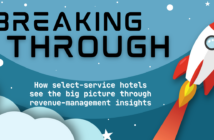1 Hotel Brooklyn Bridge Park shows how automation technology can take efforts to go green to the next level.
by BILL LALLY
| H |
ospitality technology is poised to reach new heights as hotels are seizing the opportunity to wow guests with new experiences from technology, such as artificial intelligence and augmented or virtual reality. These developments are progressing quickly, but not yet adopted by mainstream. Currently, technologies for improved sustainability have evolved into maturation and are having an impact on hotel operations and changing the industry. Leading this charge is Starwood Capital’s 1 Hotel franchise, especially with its newest location 1 Hotel Brooklyn Bridge Park.
Steps away from the iconic bridge, the hotel overlooks downtown Manhattan with sweeping views of the East River, featuring work from local artisans, complimentary electric vehicle and bicycle valet service, built-in water filters, and décor with sustainable materials such as reclaimed wood, hemp, and organic cotton. Starwood Capital set out to change the way the hospitality industry views sustainability practices with this franchise.
To accomplish their vision, Starwood worked with integration firm Mode:Green, who designed the building-wide automation system and installed each piece that’s in the hotel. Starwood was fixated on sustainability, but their investment in the system yielded additional benefit through additional guest comfort and services, and adding operational efficiency for management. The devices that are automated in the guestroom can be viewed by hotel management in a large backend, which allows them to schedule the whole room or each device to keep energy usage down. This backend is also essential for 1 Hotel Brooklyn Bridge Park, as it’s also currently tracking this data on a large scale to be analyzed in one year to influence decisions for operations and future plans.
Here’s how it works: automated lighting scenes make guestroom operation easy, incorporating multiple fixtures for easy control from a single keypad, AND a “Good Night” button sits beside the bed so guests can shut off all the lights in the room with one button press. Do-not-disturb is also electronic; guests can press a button to request privacy. Climate control is also automated, helping to provide the vital energy management data. Behind the scenes management can also use this data to see status of room occupancy so that they can properly delegate service teams.
It does become more advanced than traditional hotel automation, where a floor-to-ceiling window opens to bring in fresh air, and a sensor protects the room by automatically deactivating the air conditioning to conserve energy. And, when a storm is coming, the system can shut the window in preparation.
Designing a system like this with many devices is a challenge because technology progresses so quickly. The guestrooms, ballrooms, rooftop deck, and public spaces were equipped with the latest in automation, audiovisual, communications and energy management, but the system also can evolve to work with the latest smartphones, laptops and tablets that guests now bring into the hotel, as well as new technologies that 1 Hotel may take on later.
Technology is always evolving, becoming newer, better, faster and cheaper. Mode:Green recognized this and maximized the system capabilities to scale and evolve over time based on the goals of Starwood, while maintaining the project budget. To address this, Mode:Green selected automation provider Control4 and its dedicated Hospitality Solution for easy hotel operation. This choice was crucial to maintain the budget; it hadn’t been in the original designs. Switching to it ended up saving Starwood Capital around $400,000. Control4 was chosen because of its simple and intuitive guest experience. “That falls right in line with what we do overall, not just in hotels but also in homes and businesses,” commented David Phillips, director of hospitality and MDU sales for Control4. “In a hotel room, you have no idea who’ll be staying there. The technology needs to have a short learning curve and require no training on the guest’s part to control the system.”
Once the system is designed based on the needs of the installation – in this case, focusing on the energy management capability – and the additional feature and budget considerations of Starwood, the system is installed during construction. This project is unique among many hotel installations because 1 Hotel Brooklyn Bridge’s technology went in as it was being built, not retrofitted to an existing hotel. While the technology is often the last piece installed, it does need to be planned at the start of the design phase when the lighting, architecture, interior, and other parts of the building are being created to ensure that the technology will work with the existing plans and can be installed at the optimal time.
To ensure that every light switch, remote and thermostat is put in the right place, Mode:Green deploys a complex cataloguing and multi-tiered shipping process. This helps to deliver devices to the correct room, at the correct time during the installation, since some pieces may need to be wired in, where other devices, such as light switches, need to go in last after the walls are finished.
As the final step before opening, each room is tested by Mode:Green for proper function. For 1 Hotel Brooklyn Bridge, the process was made easier with Control4’s central-server programming that allowed faster configuration, and it was another reason why it was selected for the property. All of the considerations and construction methods that were taken into account to make 1 Hotel Brooklyn Bridge Park a smarter hotel contribute to its guest experience, brand story, and will make a true impact in energy-saving efforts today and in the future. Thought leaders such as Starwood are seeking out this type of integration as an early adopter. These hoteliers are making changes in the industry little by little, and creating a new experience expectation for guests. ■
Bill Lally is the president of hospitality integration firm Mode:Green. He has extensive experience and background in a variety of areas ranging from commercial audiovisual and control systems to energy management, broadcast, recording, post-production and hospitality.
PHOTO COURTESY OF 1 HOTEL BROOKLYN BRIDGE PARK




